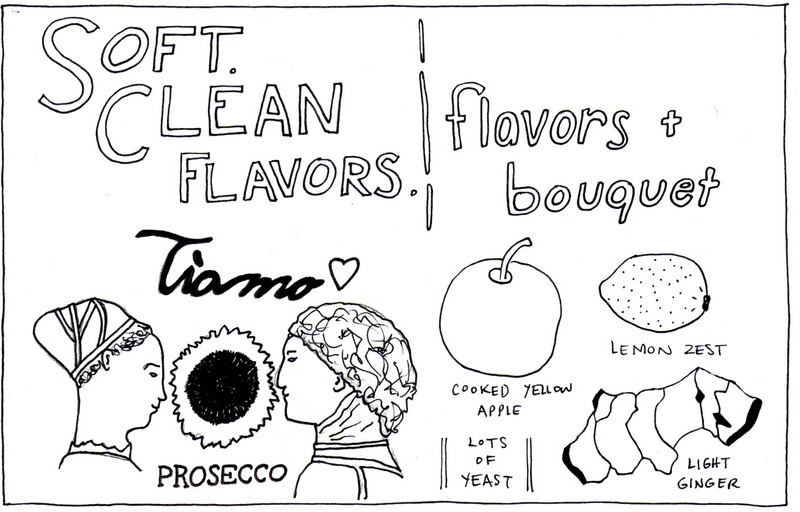Thank you to Denise for requesting a focus on Prosecco.To respond to her interest in the Italian sparkling wine we’ve got a comic that explains how this particular bubbly is made, and also three prosecco reviews.
***
Prosecco is a regulated sparkling wine from Italy made with the Glera grape. While sparkling wines made in the methode traditionelle tend to have a focus on blending, prosecco instead expresses the qualities of a single grape. Originally, the grape used in prosecco hosted the same name as the drink itself, but in 2009 the makers of the Italian beverage lobbied their wine governing board to become a regulated DOC (a quality designation), and to have the grape name changed from Prosecco to Glera in order to avoid marketing confusion. That is, other areas of the world grow glera as well, and even make sparkling wine with it. Through the name change only glera-based sparkling wine made in the Prosecco DOC can be labelled with the name prosecco. It’s a move along the lines of the reservation of the term champagne only for wines made in the Champagne region of France.
Glera is a white grape with lower acidity levels, and generally grown in warmer climates than those varieties used for methode traditionelle. Acid is considered to be one of the structural elements of wine that the other flavors shape themselves around. It’s as if acid is one of the characteristics offering backbone to a wine, while the fruit give a wine its flesh. As such, grapes with these lower acid levels are sometimes said to be “softer” as a result of the lighter bodily feel that is sensed from the reduced grape skeleton. Since prosecco is made with only use of this one grape, the drink doesn’t gain any of the structural elements that can be brought in from blending. As a result, the final sparkling wine is also thought of as softer than those sparkling wines that depend upon the presence of higher acid levels. For many, this softer structure is precisely what is appreciated about prosecco. While it may taste softer, it also carries less acidic mouth tang, and less of a mouth watering quality to it too.
In fact, as a result of the softer structure, glera is a grape that does not do well with the treatment of the methode traditionelle. Instead, it needs a less demanding process to infuse it with those precious bubbles. When treated with a secondary fermentation in bottle, a grape with these softer structural elements ends up “smudgy” both in color and in flavor.
It turns out that metodo Italiano, also known as the charmat process, is also cheaper to produce with as a result of lower handling hours. There is no need to riddle individual bottles if the secondary fermentation is happening instead in a vat. So, prosecco is not only softer than sparkling wines made with twice fermentation, it’s also generally a lot cheaper.
Here’s how it’s done.
Metodo Italiano, aka., the Charmat Process
click on comic to enlarge
And now on to the Prosecco wine reviews. I’ve been lucky enough to taste, and review several other proseccos as well, but for today we’ll focus on three affordable versions of the drink. The three appear here in order of preference.
Mionetto Gold Label NV Brut Prosecco
click on comic to enlarge
The Mionetto Brut Gold Label was my favorite of the three. It offers well-balanced, and clean flavors that remain defined. The structure is good in this prosecco, allowing rich distinctive flavor with light mouth feel.
Thank you to Jennifer at Cuvee 928 in Flagstaff, Arizona for sharing this prosecco with me.
Tiamo Prosecco
click on comic to enlarge
The tiamo is the softest of the three proseccos featured. But its flavors are also impressively clean. The fruits here are rich in the mouth, with only very light citrus, and a subtle, pleasant bite of ginger that livens up the softer texture.
Bisol Jeio Desiderio Brut Prosecco
click on comic to enlarge
The Bisol Jeio Prosecco has woody elements mixed in with fruit, white flowers, and hints of grass. I appreciated the dry precision of this wine at first, but it gains a strong white grapefruit bite as it warms. If you like the warming intensity and bite of white citrus, then you’ll appreciate this prosecco. It was the most wood and grass driven of the three, unlike the tiamo which carried almost no such notes.
***
Monday will consider an incredibly rare grape known as Charbono in the Northern Hemisphere, and Bonarda in the Southern. It’s a grape that is almost non-existant in the world, with very little growing acreage. Additionally, the flavor elements of charbono-bonarda are wonderfully unusual, and refreshing. So, for both reasons, it’s particularly exciting to have the opportunity to taste it.
Copyright 2011 all rights reserved. When sharing or forwarding, please attribute to WakawakaWineReviews.com





Why “Metodo Italiano”?
The process has been invented by the French Jean-Eugène Charmat from Montpelliers.
It is used a lot in Italy, it is true, but it is used in France, Germany, Ukraine, Moldavia, etc. too
Actually, Martinotti invented the method in Italy first at the end of the 19th century. Charmat went on to develop Metodo Italiano-Martinotti for industrial production by altering Martinotti’s tank, or autoclave in the early 20th century.
Thus, the two countries claim first naming for the process with it being called Metodo Italiano, or Metodo Italiano-Martinotti in Italy, and Charmat process in France.
Cheers!